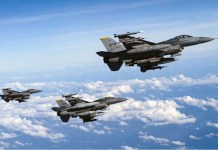How can China’s new J-20 Stealth Fighter Jet be compared to US’s F-22 Raptor? China (Chengdu J-20) and Russia (SU-57) have been working on the 5th Generation Fighter Jet to take on the American F-22 Raptor, but practically, how efficient is the Chengdu J-20 Fighter Jet or the SU-57 against the American F-22? Read EurAsian Times analysis with inputs from SCMP.
- Chengdu J20 – Russian Design, Stolen Technology from F-35?
- Russian, 5th Generation, PAK FA Jet, Not Worth the Cost without Technology
The Chengdu J-20 stealth fighter jet is developed by the Chengdu Aerospace Corporation and the aircraft entered service in March 2017. So far a few dozen J-20s have been built for the PLA, and production is on to build many more.
The F-22 Raptor was developed by Lockheed Martin for the US Air Force and their exports even to US’s closest allies like the UK and Israel are banned to preserve its stealth technology.
The F-22 entered service in December 2005 and continues to dominate the global fighter jet market. Both F-22 Raptor and Chengdu J-20 are single-seat fighter jets with stealth capabilities, but in a face-off, how would the Chinese jets compare with the US ones? Read the EurAsian Times comparison between the fighter jets and analysis on Russian SU-57.
Design: F-22 Raptor vs Chengdu J-20
Both the fighter jets, the Chinese J-20 and American F-22 are almost similar in size. The J-20 is 20.3 metres long and has a 12.9 metre wingspan, whereas the F-22’s length is 19m with a 13.6m wingspan. Made of advanced alloy elements, both the aircrafts have an empty weight of around 19,000kg.
The Chengdu J-20’s loaded weight is marginally higher than the Raptor. J-20 measures 32,000kg compared with the F-22’s 29,000kg. However, the Lockheed Martin constructed US fighter jet can take off with a maximum weight of 38,000kg, 2,000kg more than the J-20.
- Is JF-17 Thunder Fighter Jet a Better Choice than HAL Tejas?
- Russian SU-57 or American F-35: Who is Winning the Fighter Jet Market?
Engine: F-22 Raptor vs Chengdu J-20
Both the warplanes have a ceiling of 20km and a maximum speed of over Mach 2 (2,470km per hour) – faster than the speed of sound. The F-22 has a relatively shorter range – with a combat radius of 800km, while the J-20’s large internal fuel tank can support a prolonged combat radius of 1,100km.
The F-22 Raptor is propelled by afterburning turbofan F119-PW-100 engines, which permit it to supercruise at a speed of Mach 1.82. The engines have vectoring nozzles which authorise it to perform rapid manoeuvres at supersonic speeds.
The J-20’s engine gives the fighter jet a significant disadvantage. Plans for China to produce its own advanced turbofan engines are lagging behind and thus J-20 relies on secondary engines, mainly the Russian-made AL-31FM2/3 – which critically hits its manoeuvrability and stealth capacity at supersonic speeds.
Stealth: F-22 Raptor vs Chengdu J-20
As per the defence experts that EurAsian Times interviewed, the Chinese J-20’s frontal and side stealth capacities are supposed to be excellent as per the PRC and online media reports. However, it is thought to be more vulnerable to radar from the rear compared with the F-22 Raptor.
To maintain stealth, both warplanes carry their weapons in internal bays. The J-20 can carry up to six air-to-air missiles, lesser than the US F-22. But due to greater space in each bay, the Chengdu J-20 can carry longer range missiles and precision-guided bombs.
The Lockheed Martin manufactured F-22 can carry up to eight short or medium-range air-to-air or air-to-ground missiles. It also has an M61 Vulcan gun in addition to four under-wing drop tank points, which allow it to carry additional fuel or missile launchers.
- Will US Provoke China By Selling F-35 Fighter Jets To Taiwan?
- Indian Air Force Plans Israeli Spice Smart Bombs for HAL Tejas: Israel Media
Avionics and Cost: F-22 Raptor vs Chengdu J-20
Both the fighter jets possess deeply integrated avionics and sensor equipment, starring a low-observable, active electronically scanned array that can detect multiple targets in any weather conditions.
The F-22 production was terminated due to its high cost – US$62 billion for the entire project, which equates to US$339 million per aircraft. On the other hand, the Chengdu J-20’s research and development cost were measured around $4.4B, with the cost per aircraft of around 100 million, significantly less than that of the F-22.
Dead End for Russian SU-57?
As EurAsian Times reported earlier, Russia’s elite SU-57 stealth fighter jet is aggressively competing for a share in 5th generation fighter jet markets. In this US-Russia rivalry, the US seems to be edging past Russia, as the Su-57 fighter jets program is still trapped in the theoretical stages.
Russia was struggling to fund the Su-57 fighter jets program and only ordered just 12 fighter jets for themselves. Russia is in a dire need of a key investor who can inject money in SU-57 stealth fighter jets program.
In the initial stages, India was an integral part of the Russian SU-57 program. India extended its cooperation and sponsored the development of SU-57 fighter jets (PAK-FA). India’s plan was to buy these advanced stealth fighter jets which would rival F-22 and F-35.
As reported by EurAsian Times, the IAF has on several accounts reported dissatisfaction and dismay regarding the quality of the Russian aircraft. A senior officer of the Indian Air Force was concerned about the abilities of SU-57 and believes that the jet will fall short in areas of stealth and cross-section capacities. Other concerns raised by the IAF included the cost of servicing and maintenance of the fleet.
More News at EurAsian Times
- Indian Military Base in Sabang can Strangle China at the Strait of Malacca
- Major Spat Between India and Pakistan Over Free Balochistan Office In Delhi
- Saudi Arabia Halts All Oil Shipments After Yemen Missile Attack
- Saudi Crown Prince Unravels Deep Secrets Behind Wahhabism and the Yemen War




